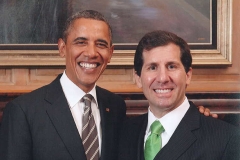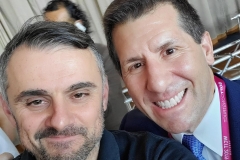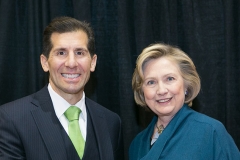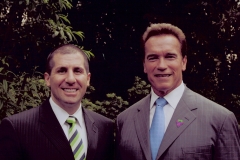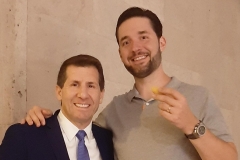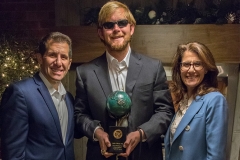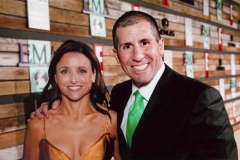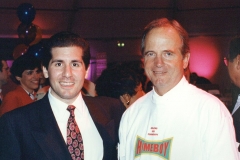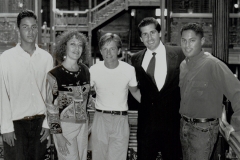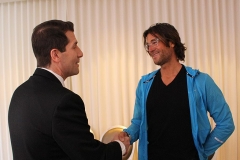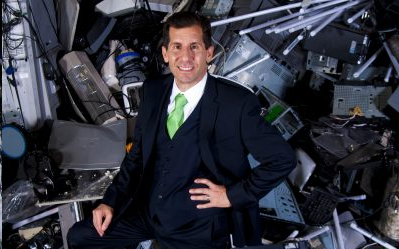
John Shegerian was recently featured on Vice’s pluspluspodcast talking about sustainable, healthy, and economically sustainable CRT recycling and the challenge facing recyclers, consumers, businesses, and the country.
The entire podcast transcription can be read below, or listen in on the embedded player below. You can also follow along on iTunes.
RAO: Hey everyone. Welcome to the second episode of Plus Plus Podcast. I’m Ankita Rao, an editor here at Motherboard.
KOEBLER: And I’m Jason Koebler, a senior staff writer here at Motherboard. This week’s episode comes to you from me. A few months back I went to a recycling center outside of Dallas, Texas, to learn where our old televisions and cell phones and fitness trackers and servers and all of that sort of stuff goes.
RAO: I love this because I have literally not thought about where my phone will go when it dies but it makes me sad to think about it now.
KOEBLER: Yeah I remember growing up and taking my stuff to this community recycling event – I think a lot of communities have that – and just throwing it in a pile and assuming that it got recycled. But as we hear in this episode a lot of the things that we get rid of end up going to these abandoned warehouses in places like Ohio and Arizona and they just get left there forever.
RAO: And that’s bad for the environment. That’s bad for economics, the country, consumers.
KOEBLER: Yeah it’s bad on a lot of fronts because a lot of our old things are very toxic and what happens is these companies pop up, they get people to pay them to take our old waste, they put them in warehouses, and then they disappear. This is a story about America’s television graveyards.
KOEBLER: I first got interested in studying e-waste while I was reporting a story about iFixit, a company that teaches people how to fix electronics in hopes of extending their functional lives. While I was reporting that story I started talking to people in the electronics recycling industry and I quickly learned that the whole industry is in crisis. Companies all over the country are struggling to recycle the estimated 705 million cathode ray tube television sols in the US since 1980. CRTs, the big box TVs you probably grew up with, contain lead which makes them dangerous to just throw away. John Shegerian, CEO of the recycling company ERI, says that state level regulation in the mid-90s created the electronics recycling industry as we know it today.
SHEGERIAN: California passed a really comprehensive law and that became the sort of the tipping point that other states should be banning CRTs from their landfills because of the hazardous materials that are contained within those CRTs – the hazardous materials being lead, phosphorus, arsenic, beryllium. So we were filling up our landfills with these very heavy products that were full of hazardous or very bad materials that when broken and rained upon in landfills would then get into our eco system, horribly affect our land and water, and then eventually our animals and of course eventually the human population.
KOEBLER: But the same things that make CRTs hazardous to bury make them hard to recycle. Taking CRTs apart is a manual process that involved dozens of people hammering, prying, and grinding away at old dusty televisions.
SHEGERIAN: You’re dealing first of all with hazardous material, a phosphorous coating. You’re dealing with what is called panel and funnel glass which have different compositions and you’re trying to figure out in a mass production way how to handle this stuff appropriately from a labor perspective and from an environmental health and safety first perspective. So when you’re juggling a business enterprise you don’t want to cure one problem, the CRT monitor problem, from going to landfills and then create another one by poisoning your laborers in your facilities o the surrounding community that you’re doing the work in.
KOEBLER: To see how the process works I went to the ECS refining plant in suburban Dallas to learn how to recycle a TV. Ric Lewis and Eric Mims gave me a tour of the facility.
LEWIS: You don’t see it LCD, LED, CRT, old school projection. The amount of these that come in amaze us. It’s still out there in the market. If you come on this side.
KOEBLER: ECS is in this massive secure building. I drove through a barbed wire gate to enter the parking lot and then I put on a hardhat before entering the secure work area. The recycling center is loud with forklifts beeping, shredders and sorting machines funneling through thousands of circuit boards, and workers dismantling servers, computers, and TVs with drills and crowbars.
LEWIS: So as you go further in you’re going to see that each layer as we go through the building I mean we’re two sets of gloves. So as we go do this we want to keep our head on this level. There are going to be trucks and forklifts and materials moving so we’ll go through it but we do want to be careful from this point forward. It’s going to be active in here.
KOEBLER: So one of the things why I’m interested in this is people don’t think about what happens to their old things like “this is what happens.” I’m wondering how toxic is a lot of this stuff? Because we don’t think about that. We don’t think about the fact that like a lot of our old electronics are toxic once you start taking them apart and is it a dangerous job. It seems that it might be.
MIMS: If you don’t dismantle that CRT tube the right way and hit that yoke the right way it can explode. So that’s why we take that – they train you here to longer to make sure that the team understands what the safety issues that it is.
KOEBLER: As you walk through the facility there are all these washing machine sized boxes called “gaylords” of fitness trackers, cell phones, and in the corner there is this long row of CRT TVs waiting to be broken down.
KOEBLER: This is 380 pounds? Or, sorry, a 340 pound TV. 500 pound TV? Oh my god.
MIMS: Okay so this is the CRT department where they manage. These are your loaders. They load the CRTs up. They pull the plastic off. The separate all the wires, throw the wires on the sort belt, and then they’ll take the tube out and the tube will go out on the – the tubes go down to the yoke station.
KOEBLER: To break down a CRT workers crowbar open the back plastic case. They cut the power cords, remove the internal screws. Each CRT has a vacuum tube that must be broken carefully with a hammer. Wires are stripped for copper. Plastic is put through a shredder. A handheld grinder is used to separate the screen from the remaining internals. Then the glass screen is smashed. Leaded glass changes color under an ultraviolet light and it’s separated out. ECS workers go through an eight day training period to learn how to do this and their blood is tested for lead once a quarter.
KOEBLER: Yeah so what am I watching?
MIMS: What it does is the challenge is to get this off without this exploding. So there’s a certain way you’re got to hit it so the tube doesn’t explode.
KOEBLER: Okay. So he does that with a hammer basically?
LEWIS: Yeah.
MIMS: Yeah.
KOEBLER: Alright yeah I want to watch him do that.
KOEBLER: As I watched all this happen it struck as an expensive, dirty, and labor intensive process. ECS, ERI, and several other companies have the equipment and manpower to demanufacture and eventually recycle CRTs profitably, but a lot of companies don’t. If you collect old TVs as a recycling business there are few ways you can rid of them. You can demanufacture them and then send the materials to a company like Camacho in Spain which turns them into ceramic tile. You can send them to Videocon in India which is the last company still making CRT TVs from recycled glass. Or you can turn the lead into flux which is used in mining. You can illegally ship CRTs to places like Hong Kong and hope you don’t get caught by regulators. Or you can send them to a middle man who can recycle them for you. The problem is many of these middle men don’t recycle at all.
SHEGERIAN: There are many companies that over the years have offered field of dreams new technology, Willy Wonka technology that they’ve invented that they’re now installing in a state that doesn’t regulate. They’ll take an old warehouse and they’ll advertise that this new technology is coming soon and people should pay them to take their CRT monitors. What we’ve seen over the last 12 years – what I’ve seen over the last 12 years of being in this industry is that is never shows up, Jason. So you then have these warehouses with tens of millions, some hundreds of millions of pounds of old CRT monitors that now are sitting there in graveyards. Some of them still whole. Some of them have been pilfered for their metals and broken inappropriately by people that have no technology and have no protective wear and have been left in these warehouses by then unscrupulous entrepreneurs that have advertised that they have some new technology which over and over again never appears. People hold their nose or turn a blind eye, never audit the facilities or audit this new technology themselves, and because they’re charging a cheaper rate than real responsible recycling really costs they go for the cheaper rate and hope that it never splashes back on them.
KOEBLER: As I talked to more people in the industry this same name came up over and over and over again – Closed Loop. Founded in 2010 by industry veterans David Cauchi and Brent Benham Closed Loop was supposed to be an American based recycling option according to Bobby Elliott, editor at large of the trade publication Resource Recycling.
ELLIOTT: Closed Loop was founded in 2010 in Arizona and then opened an additional hub in Ohio in 2012. The basic goal of the company was pretty straightforward and pretty simple. That was to provide a recycling outlet for these CRT televisions and monitors that have been flooding the e-waste stream for years now. Closed Loop was not a business started by a couple folks that had no idea what they were doing. It was started by industry veterans. It was also a company that many other companies relied on. It wasn’t a case of Closed Loop receiving a lot of business from smaller companies that were looking to cut corners. It was often a case of Closed Loop doing business with companies that were hired by major manufacturers around the world to recycle on their behalf.
KOEBLER: In its first few years Closed Loop was paid to take millions upon millions of TVs. It told regulators and its customers that it was working on a proprietary furnace that could melt leaded CRT glass into two separate commodities that could then be recycled – lead and clean glass.
ELLIOTT: The best way to think of it really is that it’s an absolutely massive warehouse space. We’re talking about hundreds of thousands of square feet of space that have been filled floor to ceiling with boxes (often broken boxes) of full old CRT televisions and then as well broken components of those televisions.
KOEBLER: Shipments of CRTs kept coming into Columbus and Phoenix but no TVs were being melted and nothing was leaving the facilities to downstream recyclers. Auditors who visited the facility over the years saw a lot of red flags. Closed Loop didn’t tell regulators about all of its warehouses and it was shipping CRTs back and forth between its facilities to make it seems as though the TVs were moving somewhere. Intake dates on the CRTs showed that they had been there for years without being broken down. Several auditors I spoke to told me that many people in the industry began to openly wonder when Closed Loop might fail. In November 2013 the company got permission from the Ohio EPA to build its furnace. But a state inspection in December 2014 found that “no work had commenced on the vacant half of the warehouse where the furnace is supposed to conduct operations.” It turns out there never was a furnace. Closed Loop shut down about a year ago after its landlord sued them and regulators deemed them to be “not a recycling facility.” Almost none of its TVs had been recycled and they’re still sitting abandoned.
ELLIOTT: A conservative estimate would be to handle all of the material in Arizona and Ohio you’d need probably at least 25 million dollars. In Arizona where the firm has over 50 million pounds of material there has been some talk between regulators there, regulators in other states, and the landlords to figure out a path toward beginning to clear out those facilities. But as of the end of 2016 there have been no steady progress on physically doing that.
KOEBLER: In Arizona there are 25 thousand tons of CRTs. In Ohio there may be as much as 100 thousand tons. These are numbers I can’t really put into perspective and it’s hard to really imagine. It’s quite literally millions of TVs. I tried for months to learn more about what specifically happened at Closed Loop. Some people think Cauchi and Benham scammed customers and absconded with millions of dollars. Others thought they meant well but got in other their head.
ELLIOTT: Where Closed Loop’s money went is an unanswered question at this point. Closed Loop was being paid to handle every device it received. What we know is that Closed Loop was also charging much less than its competitors were and that’s one of the ways in which Closed Loop was able to receive so much material in the first place. The entire time they contended all their resources were being put into R&D to go toward building this furnace. Now many in the industry don’t necessarily believe that that was the case but the company to its last days told me that they had invested all of the money in the operation and developing the technology. What those sites show us is that that process never truly started in earnest.
KOEBLER: Through their lawyer Dave Cauchi and Brent Benham declined to speak to me for this story. I’ll be honest, the mystery is gnawing at me but everyone I talked to said it’s more important to focus on the larger problem. There are a lot of other Closed Loops.
ELLIOTT: Closed Loop is not an anomaly. Closed Loop is as far as we know the largest abandonment of this kind but I’ve reported on at least a half dozen other companies that have abandoned large amounts of this material.
KOEBLER: In the last three years the EPA has found warehouses full of abandoned CRTs in Arizona, Ohio, Colorado, Pennsylvania, New York, Utah, Massachusetts, and Kentucky. The CRT problem isn’t going away and everyone I’ve spoken to said that we’re going to have to eventually pay for it.
SHEGERIAN: When we tracked the incoming amount of CRT materials into our facilities from 2005 into the early parts of 2017 we’ve only seen a 7-10% decline in volumes. There are billions of pounds of CRT monitors that still exist in warehouses, garages, office space, closets, attics, that are waiting to be responsibly recycled. If we care in American about breathing clean air and drinking clean water this is a service that those who are involved in the process, those who are generating this material have to pay for like they pay for their accountants and their lawyers and when they go to the doctor’s office and everything else. This is the dark side of the technological revolution which has benefitted all of our lives. So since we’ve all enjoyed the benefits of all the beautiful screens that we use we have to pay for the appropriate disposal of all of our technologies. There is no reason that CRT monitors in 2017 or any electronics that we touch and use should be going to landfills when they come to their natural end of life.
KOEBLER: One thing to keep in mind is that our things are not getting any easier to recycle. Flat panel TVs which contain mercury are just as hard as CRTs to break down. Smartphones and laptops are even tougher because lithium batteries are often glued in to the devices which makes them difficult to remove.
SHEGERIAN: In terms of hazardous material that’s hard to work with the next crisis that’s looming is lithium batteries. Our devices are getting smaller, the batteries are getting smaller, the batteries are hazardous, the batteries are flammable when handled inappropriately and it takes tons of man hours to pull these out and send them to a downstream legitimate responsible battery recycler. And you have because the materials get smaller people think there is less hazardous waste in them and they think it costs less to recycle them when actually the opposite is true because with these materials it takes more man power and more man hours to pull these very hazardous, very dangerous, very flammable, very toxic materials out of the small gadgets that we all seem to demand from our manufacturers and enjoy.
KOEBLER: Back at ECS Refining I saw this first hand. One by one I saw everyone grabbing little black fitness trackers out of a giant box. She cracked them with a hammer, took out the batteries, and tossed it into another box. She does this all day every single day.
LEWIS: We are literally doing manual separation at certain points to make sure we know what’s going in. Battery recovery, safety, batteries, the whole. As we go through you can see a hundred different commodities. So you could have a brick that you put a cell phone in because a cell phone is designed to go together but not come apart easily.
MIMS: Normally once we get any type of objects/material in that we have to pull batteries out of we send them over here. Normally she’ll pack them up. Grab and take (as you can see) space them out so they don’t catch fire. Once she grabs them she places them in a cardboard box and she’ll put another piece of cardboard layer on there and then continue to do it until she fills it up.
KOEBLER: So another depressing episode of Plus Plus Podcast.
RAO: Well thank you so much. It was also enlightening.
KOEBLER: Thanks everyone for listening to Plus Plus Podcast. We’ve had a pretty successful launch so far and it’s all thanks to you rating us on iTunes and telling your friends about us so please keep spreading the word.
RAO: And you can find us at @Motherboard on Twitter or at @Motherboard on Facebook and let us know what you think. You can also find Jason and I pretty much on all the social media channels.
KOEBLER: Yeah. @Jason_Koebler on Twitter.
RAO: And I’m @ANRao.
KOEBLER: This week’s episode was edited by me, Jason Koebler. Our music is by Paul Chin and our album art is by Chase Seita. We are Plus Plus Podcast. You’ve got to spell it out so tell your friends about us.
RAO: Our production intern is Charu Sinha and she is a great help to us so thank you Charu.
KOEBLER: I am Jason.
RAO: And I am Ankita and we will be back next week.

